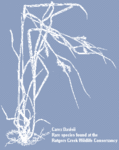Local Programs and Field Studies: Herbarium At Rutgers Creek
Rare Plant Found At The Rutgers Creek Wildlife Conservancy Greenville, NY
An herbarium collection is underway at the Rutgers Creek Wildlife Conservancy in Greenville, New York. Field Botanist, Bill Olson, has made over 350 vascular plant collections from the diverse habitats of the Conservancy, as of October, 1998. Of the plants identified, Mr. Olson has found a species listed as rare in New York by the NY Natural Heritage Foundation. Davis’ sedge (Carex davisii) is considered to be “critically imperiled in NY state because of extreme rarity (five or fewer sites or very few individuals) or extremely vulnerable to extirpation in New York State due to biological factors.”  Carex davisii is at the edge of its northern range in New York. This is only the second time it has been collected in Orange County.
Carex davisii is at the edge of its northern range in New York. This is only the second time it has been collected in Orange County.
The Rutgers Creek Wildlife Conservancy, owned by the Brandwein-Morholt Trust, includes 77 acres of diverse habitats including deciduous woods, creeks, and meadowlands. The lands are home to the Paul F-Brandwein Institute, a cooperative effort of the Brandwein-Morholt Trust and The Pocono Environmental Education Center. Paul and Mary Brandwein set aside the Conservancy lands to permanently protect it from development with the goal of providing a special place for the research and of ecology and natural systems.
The Herbarium is one of many projects providing baseline data on the Conservancy’s biodiversity. The Herbarium serves as a management aid and educational tool. The plant collection is representative of various plant communities on the site and contributes to scientific knowledge of community ecology and local biodiversity. It is the first in a series of baseline studies to be conducted on site that will include birds, insects, mosses, etc. The data collected will be archived for research and education in the region. Local schools and scientists will be encouraged to utilize the information for collaborative study and research.
The discovery of the rare species, Davis’ sedge (Carex davisii), at the northern range limit, creates potential for research on the habitat requirements for this species and for inquiry into the factors determining the range of a particular species. Research potential on the use of rare species as indicators for habitat characteristics also arises. Such research would further develop scientific understanding of the boundaries or edges of habitats.
From the beautiful spring ephemeral flora such as American Dog violet (Viola consperoa) and Red Trillium (Trillium erectum), and the summer blooming Lizard tail (Saururus cennans), to the Blue wood aster (Aster cordifolius) and Cardinal flowers (Lobelia cardinalis) that bloom in the Fall, the Conservancy provides a haven for the natural beauty of a healthy environment. The fact that it is home to a locally rare species emphasizes the importance and value of such efforts to protect and maintain open spaces in this rapidly changing region. This study, and those to follow, will provide the residents of the region with a valuable tool for measuring and monitoring the changing impact of human activities on the environment.
